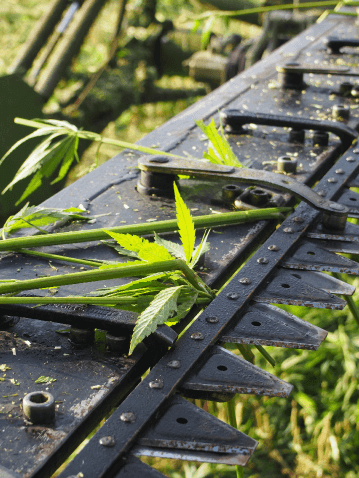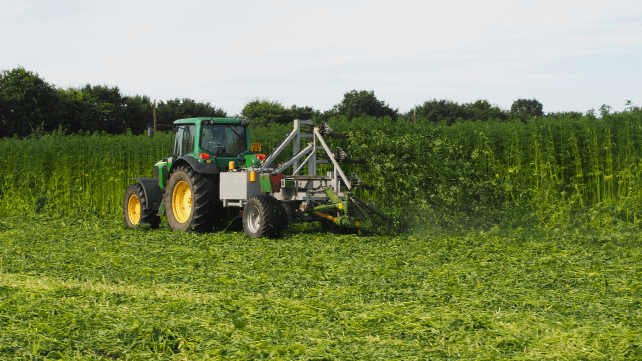Why building with hempcrete is good for the environment

Hempcrete is carbon negative
Hempcrete is a “carbon-negative” or ”better-than-zero-carbon” material; more carbon is taken out of the atmosphere by the growth of the hemp plant than is emitted as a result of its production and application on site. Various estimates for the amount of carbon sequestered have been put forward, and of course this varies depending on the exact type and source of materials, as well as on the application technique. However a leading UK manufacturer of hempcrete materials has suggested a figure of 165kg net CO2 sequestered per m3 for shuttered and hand-placed hempcrete, and 110kg CO2 sequestered per m3 for spray-applied hempcrete.
The reason the hemp plant absorbs so much carbon dioxide is because it is a tall, fast-growing plant which needs to create a hard woody stem to support itself at its full height. It grows up to 4.5 metres in around 4 months in the UK climate. The strong woody cellulose of the stem is the part chopped up and used for building. Previously this was considered a waste by-product of the oil, seed and strong fibres for which the hemp plant has long been grown. Now the whole of the hemp plant can be used!
The other main hard-wearing cellulose material used in construction is timber which, depending on the species, takes many years to grow to a useable size. Compared to timber, the fast growing hemp plant, which replenishes itself every year in just 4 months, is a truly renewable, sustainable material. The protection which the lime binder in hempcrete gives to the timber structural frame means that faster-growing softwoods can be used for the frame, further increasing the sustainability of the building as a whole.
We use hemp grown in the UK
Hemp can be grown and processed all over the world, in a range of soil types, as long as the climate is not too arid, and so can be considered a “globally local crop”; cutting down on the energy used to transport hemp shiv for building. The hemp we use for building is grown in the UK and processed on the farm before being sent straight to the building site.

The hemp plant is naturally pest-resistant and weed-suppressant, eliminating the need for chemical fertilisers and insecticides. It requires very little fertiliser, and is deep rooting; returning nutrients to the soil and conditioning the ground for the next crop. This makes it an ideal break crop for farmers in the UK to use between sowings of other crops such as winter wheat.
Hempcrete binders are made from building lime (some are pure lime, and some are 70-80% lime), which is produced by burning limestone (an abundant natural resource) in a kiln. Compared to Portland cement (which is produced from building lime with a proportion of other minerals), lime is burnt at a much lower temperature (900oC for lime compared to 1200-1400oC for cement) thus saving energy. The finished, bagged lime also has a much lower density than cement, reducing the energy used in its transport, and when it is used on site lime will re-absorb some CO2 from the atmosphere as it sets (the amount of CO2 absorbed varies with the type of lime used). The lime binders we use for hempcrete are all produced (and the raw materials are sourced) in the UK or France.
Once constructed, hempcrete walls, floors, ceilings and roofs have extraordinary thermal properties which will continue to help the environment by bringing a massive reduction in the fuel used for heating and cooling during the lifetime of the building.
Compare hempcrete to the “eco-credentials” of conventional insulation materials; which are usually made from non-renewable raw materials such as stone and fossil fuels. These insulation materials are produced using highly energy-intensive processes in factories in India and China. Raw materials are shipped halfway around the world to these factories, and the finished products shipped back to western countries using a huge amount of fuel in their transport, and production. The large chemical companies which produce these materials often have a poor record on worker safety and environmental protection, with chemical leaks from their factories creating environmental pollution. Such insulation materials are also usually treated with toxic chemicals.
Perhaps the worst aspect of conventional synthetic insulation materials is their very high embodied energy (the energy used in the extraction of the raw materials, their processing, transport, use, and disposal at end of life). Add to this the fact that they are often made from petrochemical materials derived from oil, and it is all too easy to see the huge environmental impact of these materials (which ironically are being rapidly added to our homes in the name of conserving fossil fuel resources). The argument from the large chemical companies who make these products is that using a little oil now in exchange for a carbon saving later makes sense, however recent research has shown that the huge spike in carbon emissions from the production of these materials will take decades, if not hundreds of years, to cancel itself out through carbon savings from the insulation. We don’t need a fall in carbon emissions in a hundred years’ time, we need it now!
To find out more about building with hempcrete, download our FAQs guide.
 UK Hempcrete
UK Hempcrete